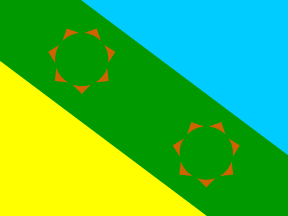
image by Jorge Candeias

FOTW beschäftigt sich mit der Wissenschaft der Vexillologie (Flaggenkunde).
Alle auf dieser Website dargebotenen Abbildungen dienen ausschließlich der Informationsvermittlung im Sinne der Flaggenkunde.
Wir distanziert uns ausdrücklich von allen hierauf dargestellten Symbolen verfassungsfeindlicher Organisationen.
Last modified: 2020-07-31 by ian macdonald
Keywords: tricolor (diagonal) | suns (2): 7 pointed | stars (2): 7 pointed |
Links: FOTW homepage |
search |
disclaimer and copyright |
write us |
mirrors
On this page:
Today the Associated Press ran a photograph of the Free Iraqi Forces in Iraq. A soldier is holding their flag. It is a blue-green-yellow diagonal tricolor and appears to have two unique, sun-like shapes on it as well.
Sean McKinniss, 11 April 2003
The two seven-pointed "sun-like shapes" look much more like following the model of the two seven-pointed stars in the 1924-1958 Iraqi flag.
Santiago Dotor, 14 April 2003
Sean McKinniss, 11 April 2003
According to a story Itsuo Inouye of Associated Press, "A U.S.-trained Free Iraqi Forces soldier waves their flag from a U.S. Army truck
as they pass through the southern Iraqi city of Nasiriyah Friday, April 11, 2003. Some of the roughly
150 Iraqi soldiers in a column of about 30 vehicles said they were heading to Baghdad to help U.S. troops."
Reported by Ivan Sarajcic, 11 April 2003
From the New York Times, 19 April 2003: "Mr. [Ahmed] Chalabi [head of the Iraqi National Congress--ed.] strode
into the news conference, smiling broadly, and took up a position under a new green, yellow and blue flag.
That same flag flew at his base in Nasiriyah, where Mr. Chalabi and some 600 of his fighters were flown from northern
Iraq this month."
Reported by Knut A. Berg, 19 April 2003
Joseph McMillan, 12 July 2005
A Portuguese TV reporter spoke in a news item on this corps about them flying "the new flag of Iraq", both as actual flags and as shoulder patches. I find highly unlikely that this is true and that this tricolor is indeed supposed to become a new flag for the country. But one never knows.... In this new flag, there are a total of 14 rays, making two "suns" of seven rays each. Perhaps there's a meaning in these numbers? Dunno. I could speculate about the two suns having to do with the two great Mesopotamian rivers, or about the colors having to do with Iraqi landscape (rivers, fertile lands and deserts), but that would be pure speculation, even if the guesses would be somewhat educated.
Jorge Candeias, 11 April 2003
Light blue for the Turkoman minority; heaven of peace green for the Arabs and green Mesopotamia; yellow for the Kurds
and deserts; two suns for a new federal state of Arabs and Kurds.
Mikhail Revnivtsev, 12 April 2003
A geographical interpretation may all that the flag is--with the central green sash standing for the fertile Tigris-Euphrates Valley. Interestingly, the slant of the sash and the yellow zone nearest the hoist (as seen from obverse at least) does reflect the alignment of desert and valley on a stylized map of Iraq.
Tony Burton, 13 April 2003
The two 7-pointed things on the FIF flag are too similar to the two 7-pointed stars on the flag of the Kingdom of Iraq (1924-1958), adopted under British protectorate) to be just a coincidence, in my humble opinion.
Jorge Candeias, 14 April 2003
From the New York Times, 19 April 2003: "In Nasiriyah, one of Mr. [Ahmed] Chalabi's aides explained that the
blue in the flag represented Iraq's mountains, the yellow its deserts and the green its famously fertile valley. Two
stylized stars on the flag represent the Euphrates and Tigris Rivers. It was not the flag of a new Iraq, the aide said,
merely of Mr. Chalabi's militia, the Free Iraqi Fighters. When asked to describe the flag today, Mr. Chalabi replied:
'I will not do that. I will not give significance to it.'"
Reported by Knut A. Berg, 19 April 2003
Hosted by: Fanshop-Online.de und Handy-Shop.de
Tipp: Apple iPhone 12 im Shop